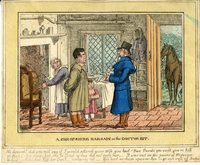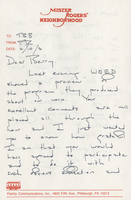Browse Items (29 total)
- Tags: Exhibit: New Treasures
Sort by:
Elizabeth D. Hay Embryological models
During her tenure as an HMS professor and researcher, Elizabeth Dexter Hay (1927-2007) achieved many notable
Cohn centrifuge bowls
After World War II, Harvard researcher Edwin Joseph Cohn (1892-1953) devised a small centrifuge in which a donor's blood could be quickly separated into its components and stored more efficiently. The centrifugal force employed divides the heavier…
Celluloid shirt collar
This collar was worn by a Boston streetcar motorman who was subject to attacks of dizziness and loss of consciousness on the job. Upon examination at Massachusetts General Hospital, it was determined that when the motorman turned his head, his stiff…
Satirical engravings
Physicians and the practice of medicine were common subjects for humorous illustrators and caricaturists in the early 19th century. Charles Williams, who worked for the London publisher and print seller, S. W. Fores, produced this set of four…
Can we fake a better doctor?
A century-old tradition, the Second Year Show allows Medical School students to unwind by turning a satiric eye on the faculty and curriculum. Programs, posters, scripts, photographs, and audio and video recordings from the productions are preserved…
Tags: Exhibit: New Treasures
Compulsion, the key to collectivism
Following U.S. Senate Committee on Education and Labor hearings on a proposed National Health Bill in 1946, the National Physicians Committee produced this pamphlet to warn against the danger of compulsory health care as a threat to the American way…
Intern : now you are the physician!
Intern was developed by two physicians based on their experiences on the house staffs at Duke University and Johns Hopkins. The object of this unusual board game is for the intern to be the first to admit, diagnose, and treat all of his or her…
Tags: Exhibit: New Treasures
Photographs of the Harvard Unit assembled by Geraldine K. Martin
In the summer of 1915, Geraldine Kemmis Martin (b. 1887) traveled to Paris as an operating nurse with the Harvard Unit of the American Ambulance Hospital and assembled an album of photographs of her colleagues and experiences in World War I. The…
La singolare dottrina
The 16th century treatise, La singolare dottrina of Domenico Romoli of Florence, describes food and herbs, recipes, and diet for the use of the "scalco" or Renaissance house steward in Italy. This copy includes two plates of cooking apparatus which…
Tags: Exhibit: New Treasures
Demorest prohibition prize medal
The Demorest prize was created by philanthropist W. Jennings Demorest (1822-1895) in 1886 to encourage young people to recite speeches of temperance movement leaders. Its medals—silver, as here, gold, and even diamond—were presented in…
Tags: alcoholism, Exhibit: New Treasures, medals, temperance
Lifecycle of HIV showing sites of actions of medications
As part of a commemoration of World AIDS Day in 1997, physician and artist Eric Avery displayed some of his work in the Strauss Gallery of Harvard's Fogg Museum in an exhibit, Art as Medicine/Medicine as Art. 3' by 6' prints of the Lifecycle of HIV…
Tags: AIDS, Exhibit: New Treasures, HIV
Codons notebooks
These three laboratory notebooks from geneticist Philip Leder (1934- ) were used while he was a postdoctoral researcher working with Marshall W. Nirenberg (1927- ). Leder and Nirenberg developed an experiment in 1964 to allow the mapping of…
Tags: Exhibit: New Treasures
Evolution of ideas on the primary visual cortex
In 1981, Harvard researchers David H. Hubel and Torsten N. Wiesel shared the Nobel Prize in Medicine with Roger W. Sperry of Caltech for their discoveries relating to information processing in visual systems. Dr. Hubel's Nobel lecture describing his…
Royal Jennerian Society for the Extermination of the Small-pox
Following the discovery of Edward Jenner, the Royal Jennerian Society was formed at the London Tavern on January 19, 1803. Under the patronage of the Prince and Princess of Wales, the society's goal was to promote the eradication of smallpox through…
A book of the records of inoculation for the kine pock
A colleague and friend of Harvard's Benjamin Waterhouse, Sylvanus Fansher (1770-1846) successfully vaccinated over 35,000 individuals in New England, New York, and New Jersey before 1816. This register, maintained by the town council of Providence,…
Adventures of a deaf-mute
Another specimen of mendicant literature is this pamphlet by carpenter William B. Swett, recounting his explorations in the mountains of New Hampshire. Proceeds from its original printing were devoted to the Boston Deaf-Mute Mission, but Swett's…
Fundamental psychological conceptions
To complement the oral history interviews of its C. G. Jung Biographical Archive, the Library collects actively in Jungian-related publications, such as this volume of transcripts of a series of lectures on dream analysis and the mind. A revised…
Tags: C. G. Jung, Exhibit: New Treasures
A history of George W. Murray, and his long confinement at Andersonville
A pattern-maker in Springfield before the outbreak of the Civil War, George W. Murray was taken prisoner, along with his three elder brothers, after the battle of Spotsylvania and confined to the infamous Confederate prison at Andersonville. He…
A hebdomadal reminiscence of diurnal events
James Arthur Emmerton (HMS 1858) of Salem used this diary every Sunday to record his experiences a student at Harvard Medical School from 1855 through 1857. He then returned to it to document life in the 23rd Massachusetts Volunteers during the…
Letter from Moses Younglove to Sylvanus Fansher
In response to an inquiry from Sylvanus Fansher (1770-1846), New York physician Moses Younglove sent this letter describing his experiences with smallpox and cowpox inoculation. Younglove claims to have inoculated over 1,400 individuals with only six…
Aberrant visual projections in the Siamese cat
In 1981, Harvard researchers David H. Hubel and Torsten N. Wiesel shared the Nobel Prize in Medicine with Roger W. Sperry of Caltech for their discoveries relating to information processing in visual systems. This article on the Siamese cat,…
Letter from Mister Rogers to T. Berry Brazelton
Dr. Brazelton, professor of pediatrics at Harvard Medical School and founder of the Child Development Unit and Brazelton Center for Infants and Parents at Childrens Hospital, created the Brazelton Neonatal Behavioral Assessment in 1973 to analyze the…
Chirurgie francoise
Principally a translation of the De chirurgia of Paul of Aegina, the Chirurgie françoise of Jacques Dalechamps incorporates information from other Classical writers as well as from Ambroise Paré, the foremost contemporary authority on…
Tags: Exhibit: New Treasures
Traite ou reflexions tirees de la pratique sur les playes d'armes a feu
Although the Countway's collections have long held copies of the second (1740) and also the 1748 and 1759 editions of Le Dran's famous treatise on gunshot wounds and military surgery, as well as the first English translation from 1743, this fine copy…
Tags: Exhibit: New Treasures
Biddenden Maids Broadside
Thought to be one of the earliest cases of surviving conjoined twins, the Chulkhurst sisters, known as the Biddenden maids, reputedly lived until 1134, although there is considerable uncertainty about the accuracy or even reality of their story. As…
Program, twenty-first annual meeting
The American Roentgen Ray Society was established in 1900 to advance knowledge of practical work with the recently discovered X-ray. It is the first and the oldest society devoted to radiology in the country.
Many of the papers and comments concern…
Minutes of the annual meeting
The American Roentgen Ray Society was established in 1900 to advance knowledge of practical work with the recently discovered X-ray. It is the first and the oldest society devoted to radiology in the country.
A stenographer present during the…





























